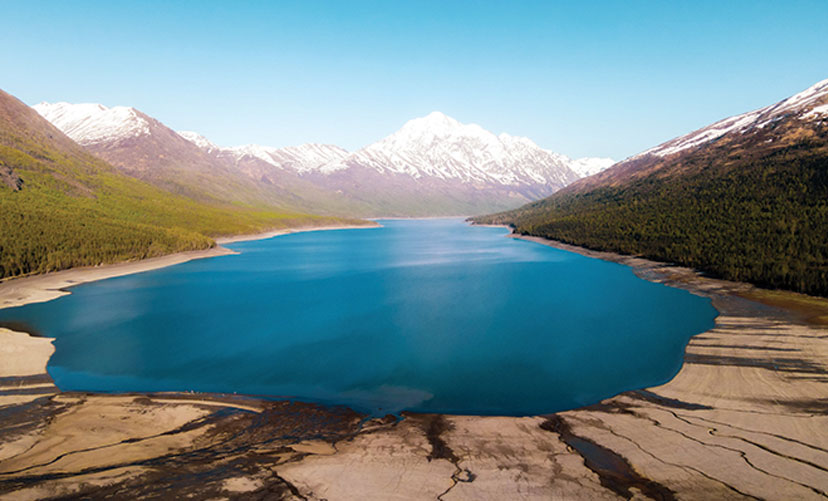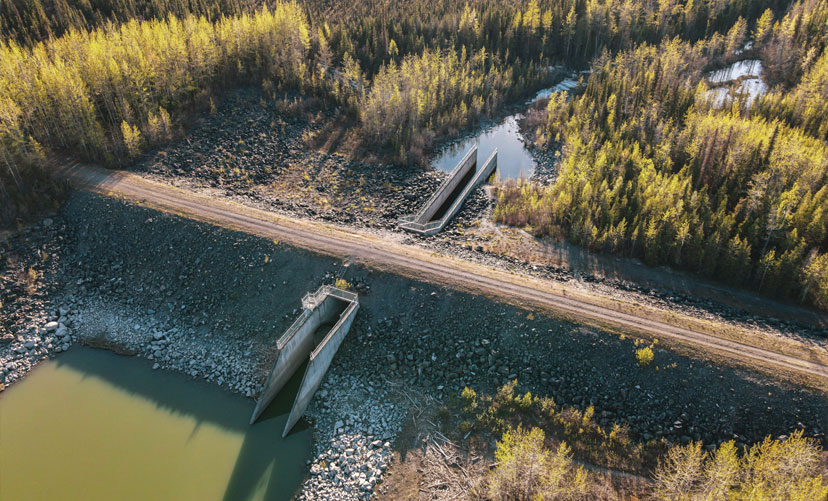Eklutna River Salmon
Blog by Eric Booton
Photos by Tyler Schwab

Currently, none of the water from Eklutna Lake is allowed to flow down the Eklutna River. 90% of what would be the river’s flow is used for power generation, and 10% is used for Anchorage drinking water.
Eklutna River Salmon: Water for Idlughetnu
Two decisions of the past, made with little consultation or consideration, decimated one of Alaska’s wild salmon rivers. For nearly a century, its indigenous stewards and historic subsistence users have been forced to live with this loss.
The grief that accompanies loss erodes us in its wake and will forever be one of the most challenging emotions for humans.
“Salmon are part of our culture; they make us who we are. But without a free-flowing Eklutna River, the salmon struggle and we struggle,” said Aaron Leggett, Chief of the Native Village of Eklutna.
I try to imagine what it was like to watch the river, inextricably tied to this community’s life and culture, first falter and then run dry. The feelings I have found are far from positive and I know I have yet to scratch the surface of the weight that has burdened the Native Village of Eklutna after witnessing the downfall of the Eklutna River, traditionally known as Idlughetnu, a weight that has been carried by generations and remains on the community today.
Built in 1929, the lower Eklutna dam blocked the migration of salmon and severed the Eklutna River in two. Salmon upstream of the dam were stranded, unable to fulfill their instinctive drive to reach the salt. Returning salmon were met by a foreign concrete wall, standing 61 feet tall, blocking access to most of the river’s spawning and rearing habitat.
Sometimes I get hung up on a particular classic dad joke: What did the salmon say when it ran into the wall? Dam! This flavor of dry humor is tragically accurate for the salmon of Eklutna. Salmon are resilient, but I have to imagine that in the years following construction of the lower dam there was no shortage of salmon saying “dam” as they bonked their heads against its concrete face.
Alas, for such a consequential construct, the useful life of the lower Eklutna dam was remarkably brief. A second hydropower project was built upstream to increase electricity production for the growing city of Anchorage. Constructed in 1955 and rebuilt after the 1964 earthquake, the currently operating Eklutna Hydroelectric Project added a diversion dam at the outlet of Eklutna Lake, approximately eight miles upstream of the lower dam site, artificially augmenting the lake’s water-storage capacity and diverting away every drop of water bound for the Eklutna River.
Irrelevant and abandoned, the lower Eklutna dam was no longer the only obstacle Eklutna River salmon faced. With the entire outflow from Eklutna Lake redirected out of the watershed, the downstream river was reduced to a trickle. Summer flows that once averaged around 1,000 cubic feet per second have been reduced to an average of 8 cubic feet per second, with groundwater seeps and small feeder streams providing the only reliable sources of flow. The river’s drastically reduced flow became inadequate to allow salmon or resident fish to access the fragmented fish habitat, preventing successful spawning and rearing.
First blocked, then made uninhabitable, the Eklutna River and its wild salmon fishery have demonstrably suffered. This unsettling fact has gone overlooked for far too long. However, growing support for restoring the river is converging with legal requirements for the dam operators to make up for the project’s impact to fish in the years ahead.
“Unbuild it and they will come,” John McMillan, Science Director for Trout Unlimited’s Wild Steelhead Initiative, enthusiastically stated in the presentation Lessons from the Elwha while characterizing the rebounds salmon and steelhead rivers make when liberated from the constrictions of dams and other fish-passage barriers.
To the rejoice of the Native Village of Eklutna and area residents, the abandoned lower Eklutna dam was removed in 2018 under the leadership of Eklutna, Inc. with support from The Conservation Fund.
With the lower dam unbuilt, fish are returning, as expected. In September of 2020, Alaska Department of Fish & Game biologists made an exciting discovery: adult and juvenile coho were observed in the Eklutna River farther upstream than previously documented. Most excitingly, the juvenile coho were found nearly a mile upstream of the lower dam site. The Alaska Department of Fish & Game anticipates a steady increase in fish populations as the habitat becomes more suitable in the coming years.
The Eklutna River currently has less than one percent of its historic summertime stream flow, which is woefully inadequate to support fish and maintain healthy fish habitat.
Removing the lower dam reconnected approximately eight miles of upstream fish habitat, but current hydroelectric operations still block access to the lake and upstream tributaries while robbing fish of the opportunity to utilize the freshly reconnected habitat between the two dam sites. Currently, 90% of the water from Eklutna Lake is diverted to generate a scant fraction of the area’s electricity, 10% of the lake’s water provides an impressive 90% of Anchorage’s water, and 0% of the lake’s outflow flows downstream to support fish. It’s an equation that, if recalculated, will unlock the Eklutna River for wild salmon.

The earthen dam at the outlet of Eklutna Lake currently does not allow any of the lake’s water to flow into the Eklutna River to provide habitat for fish. Allowing some of the lake’s water to fill the river would greatly improve spawning and rearing habitat for fish.
The Eklutna Hydroelectric Project, built by the federal government, was sold in 1997 to southcentral Alaska utility companies with the promise that the project’s impacts to fish and wildlife would be addressed. Now, 25 years later, it’s time for the utilities to make good on that promise and make up for the project’s impact to fish and wildlife.
While research and scientific studies may not get everyone’s heart racing, here is a thought that just may. In the fall of 2021, the thirsty Eklutna River will get its first drink of water in 66 years. A series of water releases from the upper Eklutna dam is on the docket for this fall. While the water releases are temporary and won’t provide the long-term flow of water that salmon need, they will provide crucial scientific information to help determine how much water is necessary to support productive fish habitat and returning salmon.
Together, Native Village of Eklutna members, anglers and area residents envision a fish-filled future for the Eklutna River—a future that we know is possible based on similar restoration projects elsewhere. Wild salmon of Idlughetnu just need the right amount of water and access to Eklutna Lake.
As you reflect on your own salmon harvest this season, the family gatherings, curbed appetites and full freezers those fish provided, consider the magnitude of the loss of that opportunity. A loss that is compounded by the fact that a century ago the people of Eklutna did not have a supermarket down the street to fall back on. Pledge your support for returning this special opportunity to Alaska’s Eklutna River at EklutnaRiver.org today.
Eric Booton is the Eklutna Project Manager for Trout Unlimited’s Alaska Program. Conserving and restoring fish habitat are his 9-5; chasing wild fish is his summer and fall pastime. Learn more about the restoration of the Eklutna River here.
This blog originally appeared as the Conservation column, titled Returning Salmon to the Eklutna River: Water for Idlughetnu in the August/September 2021 issue of Fish Alaska.
